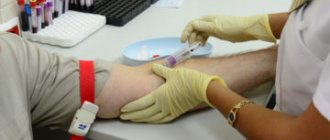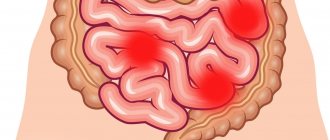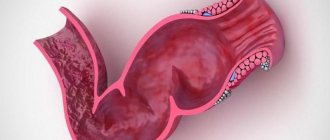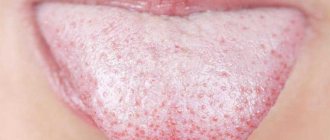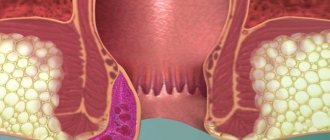- Necrosis of the fleecy surface of the mucous membrane of the digestive organs, often manifested with the formation of ulcers on them. Such processes manifest themselves in places where the parasite attaches to the walls of internal organs.
- Allergic reactions caused by toxic products produced by the parasites themselves. These processes are also affected by the decay of helminths.
- Blood loss caused by mechanical damage. Such factors often lead to the development of anemia.
- Dysbacteriosis and vitamin deficiency.
This or that pathogenic effect caused by dwarf tapeworms is fully consistent with the development cycle of these parasites in which they arrive. These tapeworms attach to the intestinal walls during the first stage of their maturation, which is called tissue. Cysticercoids mature in about 7 days, after which they detach from the intestinal villi. From this moment on, the intestinal stage begins. With its onset, the parasites re-attach to the mucous membrane of the organ, where further maturation of the parasite occurs.
Etiology
Dwarf tapeworm (natural size from 0.5 to 5 mm): 1—general type of helminths;
2— head; 3 - crown of hooks. The causative agent is the dwarf tapeworm, Hymenolepis nana (Siebold, 1852; Blanchard, 1891). Belongs to a type of flatworm, a class of tapeworms (see Flatworms). This is a small cestode from 0.5 to 5 cm long (Fig.) Its ribbon-like body consists of a head (scolex), neck and strobila. The latter consists of 160-1000 successive segments (proglottids). The ovoid scolex (diameter 0.25-0.32 mm) is equipped with four hemispherical suckers and a movable proboscis, armed with a crown of 25-30 hooks. New segments are constantly growing from the neck.
The cuticle of the cestode is equipped with microvilli and performs the functions of absorption and digestion. The parasite has a complex excretory system. The nervous system consists of a paired medullary ganglion, from which 10 trunks arise, passing through all segments and containing motor and sensory fibers. The reproductive system in each segment is independent, built according to the hermaphroditic type. Formed eggs accumulate in the uterus. A mature egg has an ellipsoidal shape, rarely spherical. Egg sizes range from 0.040 to 0.050 mm. The eggs released into the intestinal lumen contain an invasive larva (oncosphere), which can, right here in the intestine, free itself from the egg membranes and penetrate into the villi of the small intestine. In this case, intraintestinal autosuperinvasion occurs. The intertissue stage of the dwarf tapeworm is called cysticercoid, which after 4-7 days. reaches an invasive stage called larvocyst. The period of development of the parasite from the introduction of the oncosphere into the intestinal tissue to the beginning of the release of eggs ranges from 10 to 36 days, sometimes more. The lifespan of one generation of dwarf tapeworm is in most cases 1-2 months, but sometimes, apparently, up to 8-12 months.
The pathogen can go through all stages of development in the human, mouse or rat body. The larval stage can also occur in the body of some insects - intermediate hosts (mealworms, some types of fleas, etc.) - Mice and rats are parasitized by the dwarf tapeworm, which is indistinguishable in morphological characteristics from the human strain. Cross-infection of G. between humans and rodents is possible. In connection with certain biol, differences in these strains of dwarf tapeworm, ecol. helminth races: human (H. nana var. hominis), rat (H. nana var. rattus) and mouse (H. papa var. muris).
Prevention of infection in children and adults
Individual prevention for hymenolepiasis includes a set of measures:
- Regular, thorough hand washing, introducing children to the rules of personal hygiene.
- Thorough washing and processing of fruits, vegetables, herbs, if possible, it is advisable to remove the peel and peel.
- Annual medical examination with copro-ovoscopy (preferably 3 times).
- If you have allergic diseases or gastrointestinal dysfunction, perform a targeted search for helminthiases.
Public prevention consists of identifying and deworming infected people, examining all contact persons, sanitary education work in endemic areas, among tourists, and in children's clinics.
If hymenolepidosis is detected in persons working in the food industry, the person is suspended from work until the end of treatment and dispensary observation. If a disease is detected in one of the family members, everyone, including parents, is subject to examination, since helminthiasis is a contact disease.
Epidemiology
The main source of G. is a sick person. Humans can become infected from mice and rats. The main mechanism of transmission is fecal-oral. The most important transmission factors are dirty hands, as well as toys, food, and household items contaminated with feces. In untidy subjects, helminth eggs may linger on the perianal folds, which may cause epidemiol. significance, especially in cases of G.’s combination with enterobiasis (see). One of the transmission factors may be flies. The role of insects as intermediate hosts of helminths in the epidemiology of helminths on the territory of the USSR is negligible. Ascariasis has an indirect effect on the spread of G. In areas where the latter is widespread, G. is almost never found or not found at all.
G. affects mainly children of preschool and primary school age. The maximum incidence occurs between the ages of 4 and 9 years. Large outbreaks can occur in children's institutions with unsatisfactory hygiene. condition. Diseases of adults are also common.
Pathogenesis. A person's susceptibility to primary and repeated infections of G. depends on nutritional conditions, immunol, condition, concomitant diseases, climate, etc. The leading pathogenetic factors in G. are allergies and the mechanical effect of cysticercoids and mature tapeworms on intestinal tissue, as well as the effect on the host body products of their metabolism and decay. Allergies and constant intestinal microblood loss underlie the pathogenesis of anemia in G. Intestinal dysbiosis and allergic reactions are associated with disturbances in fermentation and absorption processes in the intestine. These same factors underlie hypovitaminosis B2, C and PP, observed in G. The long course of G. is caused by superinvasions, since the lifespan of one generation of helminth, as a rule, does not exceed 2 months. Superinvasion can be exogenous and intraintestinal autosuperinvasion.
Pathogenesis of the disease
The life cycle of the helminth that causes hymenolepiasis takes place in one organism, which is an intermediate host for it in the first stages, and subsequently the final host. Infection occurs by ingesting eggs. Passing through the gastrointestinal tract, the eggs are retained in the small intestine. The larva leaves the egg using hooks that tear apart the shell. Once freed, the oncosphere is implanted into the intestinal villus. Tissue invasion occurs and further transformation of the helminth into an adult begins. Going through all stages, the oncosphere is transformed into a megalosphere, metamera, and cysticercoid. This is how the tissue phase of development passes, followed by the intestinal phase, when the parasite attaches itself to the walls of the intestine. At this stage, the person becomes the final owner.
Dwarf tapeworm mechanically damages the intestinal walls, which leads to disturbances in digestive functions.
Due to damage to the walls, inflammatory processes progress, dysbiosis begins and the functions of the digestive organs are disrupted. Throughout the entire development cycle, products and substances secreted by the helminth have an allergic and toxic effect on the body. The maturation of the helminth from egg to adult takes 2 weeks.
Pathological anatomy
The villi of the small intestine affected by cysticercoids are thickened, the stroma is shifted towards the epithelium.
As the larvae mature, the phenomena of necrobiosis and necrosis intensify, the stroma is saturated with exudate and infiltrated with segmented leukocytes, and the epithelial cells are partially desquamated. In places where the head of the tapeworm is fixed, the villi are destroyed, and the resulting ulcers reach the submucosal layer. Characterized by plethora of all layers of the small intestine, hyperemia of lymphoid follicles, degeneration of nerve cells of the intestinal plexus. G. is accompanied by damage to other organs. Characterized by focal dystrophy of the myocardium and liver; proliferation of connective tissue of the liver, lungs, pancreas, myocardium; lymphoid and lymphoidoeosinophilic infiltrates in the lungs, liver, pancreas, and in severe cases - in the pia mater.
Immunity
Apparently, most people have a short-term course of G., since sufficiently strong immunity develops that prevents the occurrence of superinvasions. Under unfavorable conditions, relative immunity occurs, which is insufficient to prevent re-infections. In these cases, the disease takes a long course. At the age of 10-14 years, most children usually get rid of the invasion without treatment, which is explained by both the development of age-related immunity and the acquisition of gigabytes. skills.
Hymenolepiasis
Hymenolepidosis
Hymenolepidosis is an intestinal cestodosis that develops when a person is infected with tapeworms of the Hymenolepididae family. Hymenolepidosis occurs almost everywhere, but is most widespread in Latin America, North Africa, the Middle East, Central Asia, and Transcaucasia - the infestation of the population in these regions ranges from 1 to 34%. In Russia, cases of hymenolepiasis are recorded mainly in the Amur and Tomsk regions. The main group of patients are children aged 4-14 years: they become infected with hymenolepiasis 3.5 times more often than adults. This is explained by insufficiently developed hygiene skills and the age-specific immunity of children. Features of epidemiology and clinical course make the problem of hymenolepiasis relevant not only for infectious diseases, but also for pediatrics and gastroenterology.
Clinical picture
In one third of cases, the disease does not produce clearly expressed wedge symptoms. The most common complaints are abdominal pain, loss of appetite, nausea, unstable stools, headache, general weakness and increased fatigue, irritability, dizziness. More rare symptoms are pallor of the skin, weight loss, memory loss and absent-mindedness, convulsive muscle twitching with or without loss of consciousness, short-term increases in temperature to low-grade or febrile. In most patients with G., the acidity of gastric juice decreases, sometimes very strongly. In patients, especially children, the liver often becomes enlarged and its functions are impaired. A decrease in blood pressure is characteristic, which is directly dependent on the intensity of the invasion. An ECG in a number of patients reveals a decrease and deformation of the K wave in all leads, a lowering of the ST interval, a negative or isoelectric T wave in lead III, which indicates myocardial dystrophy. Half of the patients have hypochromic anemia. In some cases, ROE is accelerated, moderate eosinophilia of peripheral blood, mild leukopenia, and sometimes leukocytosis are observed.
Treatment
G. is one of the difficult-to-treat human helminthiases; there is always a danger of relapse. This is due to the fact that, in parallel with the tape forms, cysticercoids (see Cestodoses) can parasitize in the human body, against which anthelmintic drugs are ineffective. In addition, when insufficient doses of anthelmintic drugs are prescribed, as well as in cases of localization of scolex covered with mucus in the folds of the mucous membrane of the small intestine, the cestodes discard the strobila, and from the remaining scolex, sexually mature tapeworms can subsequently develop again.
Treatment begins immediately after diagnosis. Fenasal is the most effective. The following scheme is usually used: 6-7 two-day cycles at intervals of 4-5 days. The duration of the course is at least 35-40 days. Fenasal is prescribed once a day in doses: children 1-2 years old - 0.3 g, 3-4 years old - 0.5 g, 5-6 years old - 1 g, 7-10 years old - 1.5 g, 11 years and older, as well as for adults - 2 g. On the eve and on the days of taking phenasal, easily digestible food with limited fiber is recommended. On the first day of treatment, Fenasal is given in the morning on an empty stomach, after 1.5 hours - a light breakfast (a glass of sweet tea with a bun or cookies). 2-3 hours after taking phenasal, take a saline laxative (only on the first day of the first cycle). On the remaining days of treatment, Fenasal is given either in the morning on an empty stomach 1.5 hours before meals, or at night 1.5-2 hours after a light dinner. Immediately before taking, the powder is poured into a glass, poured with two to three tablespoons of boiling water, stirred thoroughly, topped up with warm water to 1/3 of a glass, stirred again, cooled and allowed to drink. Treatment with ethereal extract of male fern is less effective; the course of treatment in Crimea consists of three cycles with breaks between them of 7 days. Each cycle consists of two days of preparation and one day of taking the drug. During preparation and treatment days, a low-fat diet is recommended. Single (daily) doses of essential extract of male fern: children 2 years old - 0.2 g, 3-4 years old - 0.3 g, 5-6 years old - 0.5 g, 7-8 years old - 0.6 g, 9 -10 years - 0.7 g, 11-12 years -0.9 g, 13-14 years - 1 g, 15 years and adults - 1.5 g. During treatment, it is important to ensure adequate nutrition for the patient. Vitamins C and B complex, colibacterin, and St. John's wort decoction are recommended. Simultaneously with the treatment, a complex of sanitary hygiene is carried out. activities (disinfection of pots, etc., change of underwear and bed linen at the end of the first day of treatment, compliance with personal hygiene rules).
Those individuals who within 6 months can be considered cured. after the end of the course of treatment, no dwarf tapeworm eggs were found in 4-6 control stool tests. In persistent cases of G., it is advisable to increase the period of clinical observation to a year, and the number of control studies to 8-10 (6 analyzes during the first half of the year - monthly, 2-4 analyzes - during the second half of the year). In cases of detection of eggs, a repeated course of treatment is recommended.
Prevention or how to avoid becoming infected with dwarf tapeworm
You must be careful and follow all personal hygiene rules. Remember that almost 90% of parasites enter the human body through the oral cavity, which means this is possible by drinking dirty water, eating dirty, unwashed foods, or by not properly cooking food.
Attention. Naturally, dirty hands play an important role in the transmission of hymenolepiasis, because we are constantly in society, we handle door handles, handrails, and various other objects; money and public toilets are especially dangerous, where the number of various infections is enormous.
It is worth remembering that cleaning the room, washing clothes, installing various insect repellent devices, all of this can significantly reduce the chances of becoming infected with dangerous helminths, which can cause significant harm to you and your family members.
Learn to be careful yourself, and make sure your children learn the same.

